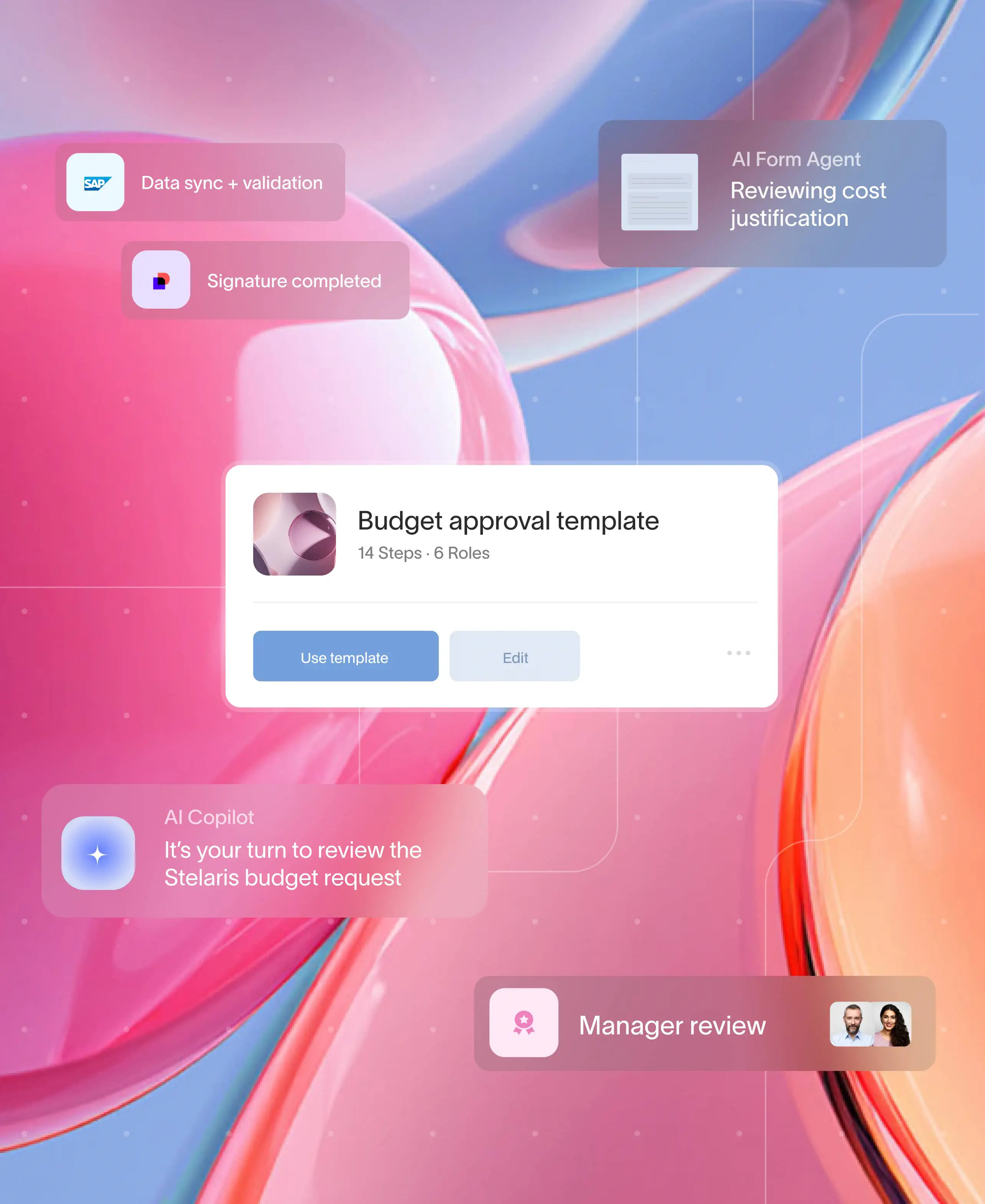
At a glance
For most businesses, contracts are where good intentions meet operational reality. Leaders agree on a deal, but the actual contract takes weeks to finalize. Terms get lost in email, approvals sit in limbo, and clients or vendors grow frustrated. These delays don’t just waste time — they damage relationships and delay revenue.
The problem is widespread. EY reports that contract managers spend more than 30% of their time on administrative tasks such as chasing approvals and reconciling document versions. That means highly skilled professionals spend nearly one-third of their time on low-value work instead of advising the business.
A structured contract management workflow changes this dynamic. To make it tangible, let’s walk through a contract management example and break down how orchestration transforms every stage. For the broader context, see our complete guide to contract management workflow.
The challenge: contract chaos in a growing business
Imagine a fast-growing marketing agency signing new clients every week. On paper, the business is thriving. In reality, every new contract creates chaos:
- Drafting delays. Each account manager creates contracts from scratch, leading to inconsistent terms.
- Negotiation confusion. Clients send redlines via email, and different versions circulate simultaneously.
- Approval bottlenecks. Finance and legal sign-offs are buried in inboxes.
- Execution issues. Clients don’t have an easy way to sign digitally, causing further delays.
- Missed renewals. Spreadsheets fail to track when contracts are expiring, so renewals slip.
The agency’s average contract cycle time? 35 days. Deals stall, onboarding is delayed, and client satisfaction suffers.
The solution: an orchestrated contract management workflow
By adopting a structured workflow, the agency transformed contract management into a repeatable, efficient process:
1. Drafting with templates. Contracts now start from pre-approved templates, ensuring legal consistency. Account managers fill in client-specific details instead of reinventing the document.
2. Streamlined negotiation. Clients and account managers collaborate on a single document in a secure portal. Redlines and comments are tracked centrally, eliminating version chaos.
3. Automated approvals. Finance and legal approvals are routed automatically, with reminders sent when tasks stall. Escalations ensure no approval sits idle.
4. Client-facing execution. Clients sign securely through the same portal, reducing friction and eliminating the need for third-party tools.
5. Renewal visibility. Contracts are tracked with built-in reminders for renewals, ensuring no opportunity slips away.
Within three months, the agency cut contract cycle times by 40%, improved renewal rates, and delivered a more professional client experience.
Why this matters commercially
This example illustrates why contract management isn’t just about compliance — it’s about business outcomes:
- Faster revenue recognition. Contracts move from draft to signature in weeks, not months.
- Reduced risk. Every approval is logged, protecting the business in audits.
- Client trust. A seamless contract experience strengthens relationships.
- Operational efficiency. Teams spend less time chasing and more time closing.
According to WorldCC, 81% of businesses say improving contract processes would directly improve revenue and profitability. This isn’t a back-office concern — it’s a growth lever.
Industry-specific examples
While the marketing agency scenario is relatable, contract management challenges span industries. Here are three more real-world examples:
Financial services. A bank onboarding corporate clients requires approvals across compliance, risk, and legal. Without orchestration, this takes months. With workflows, approvals are structured, and clients onboard 30% faster.
Legal services. A law firm managing client retainers often lost track of renewals. By orchestrating contracts, the firm ensured every renewal was tracked and approved, improving retention and compliance.
Procurement. A manufacturer handling hundreds of supplier agreements reduced disputes by centralizing version control and logging every approval.
For a closer look at negotiation specifically, see our post on the contract negotiation workflow.
What to look for in a contract management platform
Not all platforms address these challenges. Many focus only on internal teams or act as repositories without orchestration. A modern solution should include:
- Client-facing participation so external parties can review, redline, and sign securely.
- Audit-ready tracking to log every revision and approval.
- Automation for routing, reminders, and escalations.
- Templates and version control for consistency.
- Integrations with CRMs and financial systems.
Moxo’s workflow orchestration platform was designed for these multi-party scenarios. Unlike headless or internal-only tools, it orchestrates the full process — combining automation, human approvals, and client collaboration in one secure flow.
Best practices every business can adopt
1. Standardize from the start. Use templates for consistency across contracts.
2. Automate approvals. Don’t rely on manual reminders — let workflows route tasks.
3. Involve clients directly. Give clients a professional, branded experience to review and sign.
4. Track renewals proactively. Set workflows to trigger renewal reminders 90 days before expiration.
5. Measure cycle times. Track metrics to continuously identify bottlenecks.
For more, see our article on building an efficient contract workflow.
Frequently asked questions
What is a real-world contract management example?
A marketing agency reduced contract cycle time by 40% by adopting workflows that automated approvals, centralized negotiation, and tracked renewals.
How do contract workflows impact revenue?
They shorten cycle times, enabling faster revenue recognition and reducing lost opportunities.
Can workflows improve client experience?
Yes. A smooth contract process signals professionalism, reduces frustration, and strengthens trust.
What industries benefit most from contract workflows?
Financial services, legal, procurement, and professional services see the most impact due to the number of stakeholders involved.
Do small businesses benefit from workflows?
Absolutely. Even modest contract volumes gain from reduced admin burden and greater professionalism.
Streamline your contracts
Contracts shouldn’t slow down your business. As this example shows, a structured workflow transforms contract management into a growth driver. Moxo enables organizations to orchestrate contracts end-to-end with automation, auditability, and client-facing collaboration. Book a 15 minute demo and discover how Moxo can help you replicate these results.





